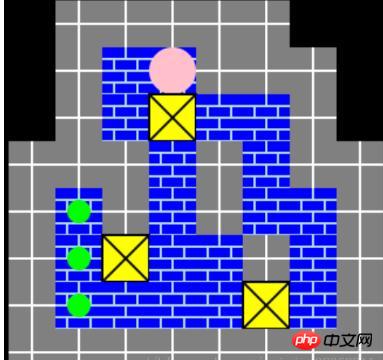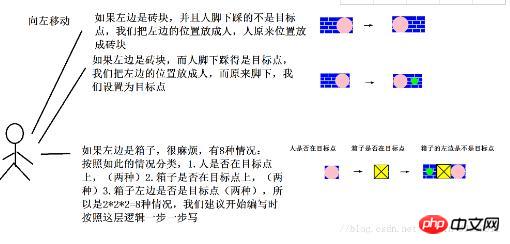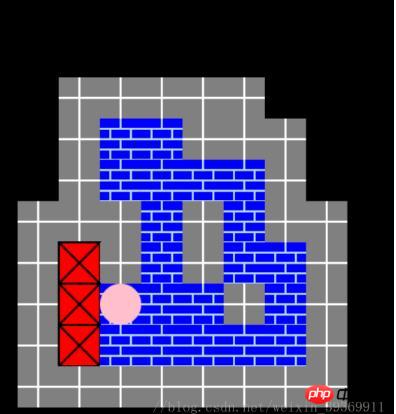Rumah >hujung hadapan web >tutorial js >JS和H5编写推箱子游戏
JS和H5编写推箱子游戏
- 小云云asal
- 2018-03-17 16:24:492164semak imbas
推箱子小游戏是一款多年前很流行的小游戏(即使现在也有很多人玩),游戏目的很简单,就是人推箱子,把所有的箱子推到目的地,就游戏成功:看似跟简单的逻辑,其实还是有一定难度的,我也是依靠了别人的帮助才完成的,现在开始介绍如何用js,html5编写该游戏(方便起见我们把人用一个粉圆形代替):
一.能力要求
JavaScript,HTML画布,面向对象的基本思想,合理的编程逻辑。
二.编写顺序
1.pushBox.html文件
2.pojo.js文件(用来存放所有的对象)
3.paint.js文件(用来写画画的语句)
4.game.js文件(用来写运行逻辑部分)
5.allLevels.js文件(用来存放关卡)
*注:这是我的书写习惯,按内容和功能将个各类分开,如有更好地写法欢迎评论
三.开始编写
1.建立基本的pushBox.html文件:
内容很简单,6c04bd5ca3fcae76e30b72ad730ca86d里面仅仅需要5ba626b379994d53f7acf72a64f9b697标签,设置id,其后的b97864c2e0ef2353a16c4d64c7734e92文件在逻辑部分做完后再加进去:
<body> <canvas id='can1' width=1536 height=733></canvas> <audio id="walk" autoplay></audio> <audio id="push" autoplay></audio> <audio id="win" autoplay></audio> </body>
3f1c4e4b6b16bbbd69b2ee476dc4f83a有引入其他四个.js文件,还有一个调用run()方法:
<script type="text/javascript" src="pojo.js"></script>
<script type="text/javascript" src="game.js"></script>
<script type="text/javascript" src="paint.js"></script>
<script type="text/javascript" src="allLevels.js"></script>
<script>
window.onload = function(){
run();
}
</script>2.写pojo类:
首先我们需要知道总共有这些类:
人,箱子,目标点,砖块和围墙,很简单,所有的类都有color(颜色),size(边长/半径),x(横坐标),y(纵坐标)这些属性。然后我们要记得,人和砖块可能和目标点重合,所以在箱子和人的类里面要加上isOnTarget(是否和目标点重合)属性,这样就完成了:
//人类
function Person(x, y){
this.color = 'pink';
this.size = 20;
this.x = x;
this.y = y;
//判断这个人是否在目标点上
this.isOnTarget = false;
}
//箱子类
function Box(x, y){
this.color = 'yellow';
this.size = 40;
this.x = x;
this.y = y;
//判断某个箱子是否在目标点上
this.isOnTarget = false;
}
//目标点类
function Target(x, y){
this.size = 12;
this.x = x;
this.y = y;
this.color = 'lime';
}
//地砖类
function Brick(x, y){
this.x = x;
this.y = y;
this.size = 40;
}
//围墙类
function Wall(x, y){
this.x = x;
this.y = y;
this.size = 40;
}3.编写paint.js类
我们需要对刚刚在pojo.js类中写的所有类写出画的方法:
需要注意一点很重要:我们如果使用确定的x,y坐标,比如说要画箱子:
ctx.fillRect(x, y, size, size);
如果如下面的方式调用的话,我们在allLevels里面这样画这个箱子:
ctx.fillRect(500, 500, 40, 40);
我们就无法确定这个箱子的旁边是什么,不好判断,于是没有办法写逻辑层。
所以,我们这样构思:我们用一个二维数组来构造这个关卡,每一个物块(箱子,人,目标点,砖块或者墙)都放到这个数组当中,arr1[][],像这样:
var arr1 = [ ['','wall','wall','wall','wall','wall','',''], ['','wall','brick','person','wall','wall','wall',''], ['','wall','brick','box','brick','brick','wall',''], ['wall','wall','wall','brick','wall','brick','wall','wall'], ['wall','target','wall','brick','wall','brick','brick','wall'], ['wall','target','box','brick','brick','wall','brick','wall'], ['wall','target','brick','brick','brick','box','brick','wall'], ['wall','wall','wall','wall','wall','wall','wall','wall'] ];
比如说arr1[0][1]就是墙了,这样一来就能写逻辑层了。而且还有一个优点,就是我们在之后创建新关卡的时候很方便,只需要按照坐标顺序在数组里写出来即可。
所以,我们在paint.js里面这样写,每个方法里面都把x和y进行一些运算,使它能正确地在网页中画出:
//首先还是清屏
function clearScreen(ctx){
ctx.clearRect(0,0,1536,750);
}
//画人
function paintPerson(ctx, x, y, size,color){
ctx.beginPath();
ctx.fillStyle = color;
//我们在内部就写好该往哪里画,传过来的x,y坐标值就可以直接在里面计算了
ctx.arc(530+x*size*2+20, 180+y*size*2+20, size, 0, 2*Math.PI);
ctx.fill();
}
//画箱子
function paintBox(ctx, x, y, size,color){
ctx.beginPath();
ctx.fillStyle = color;
ctx.fillRect(530+x*size, 180+y*size, size, size);
ctx.strokeStyle = 'black';
ctx.lineWidth = 2;
ctx.moveTo(530+x*size, 180+y*size);
ctx.lineTo(530+x*size+size, 180+y*size+size);
ctx.stroke();
ctx.beginPath();
ctx.moveTo(530+x*size+size, 180+y*size);
ctx.lineTo(530+x*size, 180+y*size+size);
ctx.stroke();
ctx.strokeRect(530+x*size, 180+y*size, size, size);
}
//画目标点
function paintTarget(ctx, x, y, size,color){
ctx.beginPath();
ctx.fillStyle = color;
ctx.arc(530+x*size*4+20, 180+y*size*4+20, size, 0, 2*Math.PI);
ctx.fill();
}
//画地砖,其中用了for循环简化了代码量
function paintBrick(ctx, x, y, size){
ctx.beginPath();
ctx.fillStyle = 'blue';
ctx.fillRect(530+x*size, 180+y*size, size, size);
ctx.strokeStyle = 'lightblue';
for(var i = 0; i <= 3; i++){
ctx.beginPath();
ctx.moveTo(530+x*size, 180+y*size+0.25*(i+1)*size);
ctx.lineTo(530+x*size+size, 180+y*size+0.25*(i+1)*size);
ctx.stroke();
}
for(var i = 0; i < 4; i++){
ctx.beginPath();
if(i%2 == 0){
ctx.moveTo(530+x*size+0.5*size, 180+y*size+0.25*i*size);
ctx.lineTo(530+x*size+0.5*size, 180+y*size+0.25*(i+1)*size);
ctx.stroke();
}else{
ctx.moveTo(530+x*size+0.25*size, 180+y*size+0.25*i*size);
ctx.lineTo(530+x*size+0.25*size, 180+y*size+0.25*(i+1)*size);
ctx.stroke();
ctx.beginPath();
ctx.moveTo(530+x*size+0.75*size, 180+y*size+0.25*i*size);
ctx.lineTo(530+x*size+0.75*size, 180+y*size+0.25*(i+1)*size);
ctx.stroke();
}
}
}
//画围墙
function paintWall(ctx, x, y, size){
ctx.beginPath();
ctx.fillStyle = 'gray';
ctx.fillRect(530+x*size, 180+y*size, size, size);
ctx.strokeStyle = 'white';
ctx.beginPath();
ctx.moveTo(530+x*size+0.5*size, 180+y*size);
ctx.lineTo(530+x*size+0.5*size, 180+y*size+size);
ctx.stroke();
ctx.beginPath();
ctx.moveTo(530+x*size, 180+y*size+0.5*size);
ctx.lineTo(530+x*size+size, 180+y*size+0.5*size);
ctx.stroke();
}然后,我们在调用画的方法时候这样调用,按照每个物块在数组中的位置进行画画:
unction getMap(ctx, person){
clearScreen(ctx);
for(var i = 0; i<arr1.length; i++){
for(var j = 0; j<arr1[0].length; j++){
//画初始图
if(arr1[i][j] == 'wall'){
//这样我们就把坐标作为参数,引入到那些paint方法里,经过计算,在网页中正确显示了
paintWall(ctx,j,i,40);
}else if(arr1[i][j] == 'brick'){
paintBrick(ctx, j, i,40);
}else if(arr1[i][j] == 'target'){
paintBrick(ctx, j, i,40);
paintTarget(ctx, j, i,10,'lime');
}else if(arr1[i][j] == 'box'){
paintBrick(ctx, j, i,40);
var index = getBoxIndex(boxes,i,j);
if(boxes[index].isOnTarget){
paintBox(ctx, j, i,40,'red');
}else{
paintBox(ctx, j, i,40,'yellow');
}
}else if(arr1[i][j] == 'person'){
paintBrick(ctx, j, i,40);
paintPerson(ctx, j, i,20,'pink');
}
}
}
}在game.js里面的run()调用getMap()方法后,效果就是这样:

4.game.js类:
首先我们还是需要创建人和箱子的对象:
var person = new Person(0,0);
var boxLevel1Count = 3;
var boxes = new Array(boxLevel1Count);
for(var i = 0;i<boxLevel1Count;i++){
boxes[i] = new Box(0,0);
}然后我们要知道人在二维数组中的位置(坐标),以及三个箱子在其中的坐标需要以下两个方法:
//找到人的坐标
function findPerson(){
for (var i = 0; i < arr1.length; i++) {
var tmp = arr1[i];
for (var j = 0; j < tmp.length; j++) {
if (arr1[i][j] == 'person') {
//使用json传变量
return {personX:i,personY:j};
}
}
}
}
//找箱子的坐标,并把他们放到数组里
function findBox(){
var count = 0;
for (var i = 0; i < arr1.length; i++) {
var tmp = arr1[i];
for (var j = 0; j < tmp.length; j++) {
if (arr1[i][j] == 'box') {
boxes[count].x = i;
boxes[count].y = j;
count++;
}
}
}
return boxes;
}找到人的坐标之后,我们要把person对象的x,y和二维数组里的i,j关联起来,就是:
//接收person的坐标 var position = findPerson(); //i是person的横坐标 var i = position.personX; //j是person的纵坐标 var j = position.personY; //使对象的属性和人在二维数组的坐标关联 person.x = i; person.y = j;
<br/>
然后我们就可以开始写逻辑了,比如说用户按方向键左,要判断左边是什么,如果是箱子的话,还要判断箱子的左边是什么:
正确的逻辑如下所示(我们就拿人往左移动为例,然后上下右都是一样的):

具体的语法很简单:比如说,按照第一个为例,左边是砖块,并且人踩的不是目标点:
if(arr1[i][j-1] == 'brick'){
arr1[i][j-1] = 'person';
arr1[i][j] = 'brick';
Audio1.src = '走路emm.wav';
}如果我们下一步,人踩到了目标点,我们就要把person.isOnTarget 设置为true,当人移开时候,我们把这个属性设置为false
当人左边是箱子的时候,比较麻烦,首先必须明白有一点:我们到底推的是哪个箱子?之前已经有了一个存放所有箱子的数组了,所以现在需要一个方法,可以让我们知道我们推的是哪个箱子:
function getBoxIndex(boxes, i,j){
var index = 0;
for(var k = 0;k<boxes.length;k++){
if(boxes[k].x == i && boxes[k].y == j){
//找到了这个箱子的下标
index = k;
}
}
return index;
}在实际调用中,里面的参数(i,j)就写下一步要走的那个位置,比如说向左走,就是
var index = getBoxIndex(boxes, i,j-1);
这个index就是我们要找的第i个箱子了,接下来就很好办了,我们按照刚才的逻辑一步一步写,一堆的if、else,只需注意两点,当人踩到目标点时,把person.isOnTarget = true,移开之后false;箱子踩到目标点时boxes[index].isOnTarget = true,移开之后false,然后再整理一下,简化代码量,就是:
//玩家操作
document.onkeydown = function(ev){
var oCan = document.getElementById('can1');
var ctx = oCan.getContext('2d');
var oEvent = ev || event;
var Audio1 = document.getElementById('walk');
var Audio2 = document.getElementById('push');
//接收person的坐标
var position = findPerson();
//i是person的横坐标
var i = position.personX;
//j是person的纵坐标
var j = position.personY;
//使对象的属性和人在二维数组的坐标关联
person.x = i;
person.y = j;
if(oEvent.keyCode == 37){
if(person.isOnTarget){
if(arr1[i][j-1] == 'brick'){
arr1[i][j-1] = 'person';
arr1[i][j] = 'target';
person.isOnTarget = false;
}else if(arr1[i][j-1] == 'box' && arr1[i][j-2] != 'wall' && arr1[i][j-2] != 'box'){
var index = getBoxIndex(boxes, i,j-1);
if(!boxes[index].isOnTarget){
if(arr1[i][j-2] == 'brick'){
arr1[i][j-2] = 'box';
arr1[i][j-1] = 'person';
arr1[i][j] = 'target';
person.isOnTarget = false;
}else if(arr1[i][j-2] == 'target'){
arr1[i][j-2] = 'box';
arr1[i][j-1] = 'person';
arr1[i][j] = 'target';
person.isOnTarget = false;
boxes[index].isOnTarget = true;
}
}else if(boxes[index].isOnTarget){
if(arr1[i][j-2] == 'brick'){
arr1[i][j-2] = 'box';
arr1[i][j-1] = 'person';
arr1[i][j] = 'target';
boxes[index].isOnTarget = false;
}else if(arr1[i][j-2] == 'target'){
arr1[i][j-2] = 'box';
arr1[i][j-1] = 'person';
arr1[i][j] = 'target';
}
}
boxes[index].y--;
}else if(arr1[i][j-1] == 'target'){
arr1[i][j-1] = 'person';
arr1[i][j] = 'target';
}
}else if(!person.isOnTarget){
if(arr1[i][j-1] == 'brick'){
arr1[i][j-1] = 'person';
arr1[i][j] = 'brick';
}else if(arr1[i][j-1] == 'box' && arr1[i][j-2] != 'wall' && arr1[i][j-2] != 'box'){
var index = getBoxIndex(boxes, i,j-1);
//箱子踩的不是目标点
if(!boxes[index].isOnTarget){
//箱子左边是地面
if(arr1[i][j-2] == 'brick'){
arr1[i][j-2] = 'box';
arr1[i][j-1] = 'person';
arr1[i][j] = 'brick';
}//箱子左边是目标点
else if(arr1[i][j-2] == 'target'){
arr1[i][j-2] = 'box';
arr1[i][j-1] = 'person';
arr1[i][j] = 'brick';
boxes[index].isOnTarget = true;
}
}else if(boxes[index].isOnTarget){
if(arr1[i][j-2] == 'brick'){
arr1[i][j-2] = 'box';
arr1[i][j-1] = 'person';
arr1[i][j] = 'brick';
boxes[index].isOnTarget = false;
person.isOnTarget = true;
}else if(arr1[i][j-2] == 'target'){
arr1[i][j-2] = 'box';
arr1[i][j-1] = 'person';
arr1[i][j] = 'brick';
person.isOnTarget = true;
}
}
boxes[index].y--;
}else if(arr1[i][j-1] == 'target'){
arr1[i][j-1] = 'person';
arr1[i][j] = 'brick';
person.isOnTarget = true;
}
}
}这样,向左走的所有逻辑就完成了,然后是上,右,下,接着else if 就行,照猫画虎,把里面的i和j一更换就完成了。
所有逻辑写完,验证无误后,我们要判断通关条件,这个很简单,当所有的箱子都isOnTarget时候,成功,当然是在每次按完方向键之后都要判断:
function judgeWin(boxes){
var count = 0;
for(var p = 0;p<boxes.length;p++){
if(boxes[p].isOnTarget)
count++;
}if(count == boxes.length){
var Audio3 = document.getElementById('win');
Audio3.src = '鼓掌.mp3';
alert('You Win! 一共走了'+countStep+'步');
}
}通关的画面如下:

最后,我们加入音效,主要划分成以下几类:人走到砖块的,人推箱子的,人碰到墙的(和人推箱子碰到墙的),成功后的掌声。
总结:
1.我开始以为这个很简单,和我之前做的那个flappy bird 差不多,没想到这里面的逻辑其实很复杂,我的flappy bird链接如下:点击打开链接。所以,一定要在刚开始的时候要构思好大局,别越写越麻烦,容易产生放弃心里。
2.利用二维数组存放地图,然后在paint()方法里面写画的位置,大小等,调用的时候paint()里面就填坐标,这样有两个好处:(1)可以知道每个物块的上下左右都是什么,易于判断;(2)新建关卡的时候易于创建,只需要按照坐标位置,把wall,brick,person,target,box放进去即可
3.在创建人的对象后,我们需要在地图数组中把人的坐标找出来,然后将对象的x,y属性和坐标关联;在创建箱子的对象数组后,我们需要getIndex()方法,找到人到底推的是哪个箱子,才能使这个箱子的isOnTarget改成true或者false,这两点很关键。
Atas ialah kandungan terperinci JS和H5编写推箱子游戏. Untuk maklumat lanjut, sila ikut artikel berkaitan lain di laman web China PHP!
Artikel berkaitan
Lihat lagi- Analisis mendalam bagi komponen kumpulan senarai Bootstrap
- Penjelasan terperinci tentang fungsi JavaScript kari
- Contoh lengkap penjanaan kata laluan JS dan pengesanan kekuatan (dengan muat turun kod sumber demo)
- Angularjs menyepadukan UI WeChat (weui)
- Cara cepat bertukar antara Cina Tradisional dan Cina Ringkas dengan JavaScript dan helah untuk tapak web menyokong pertukaran antara kemahiran_javascript Cina Ringkas dan Tradisional

